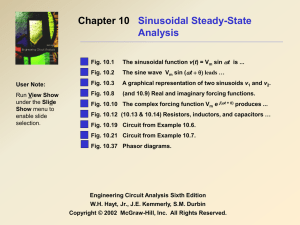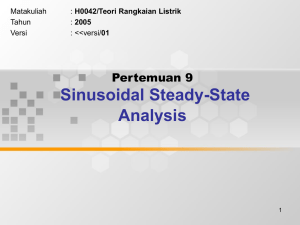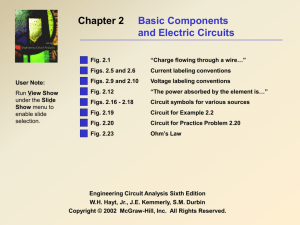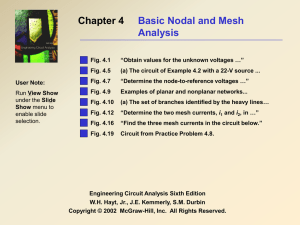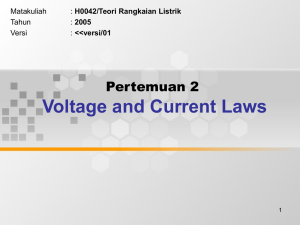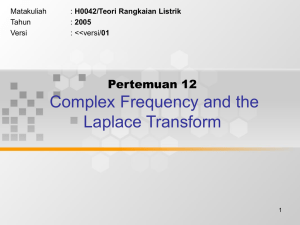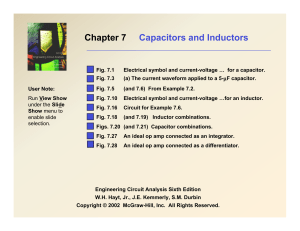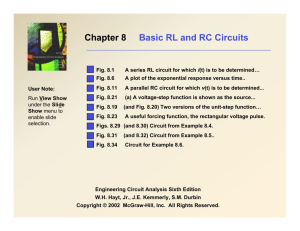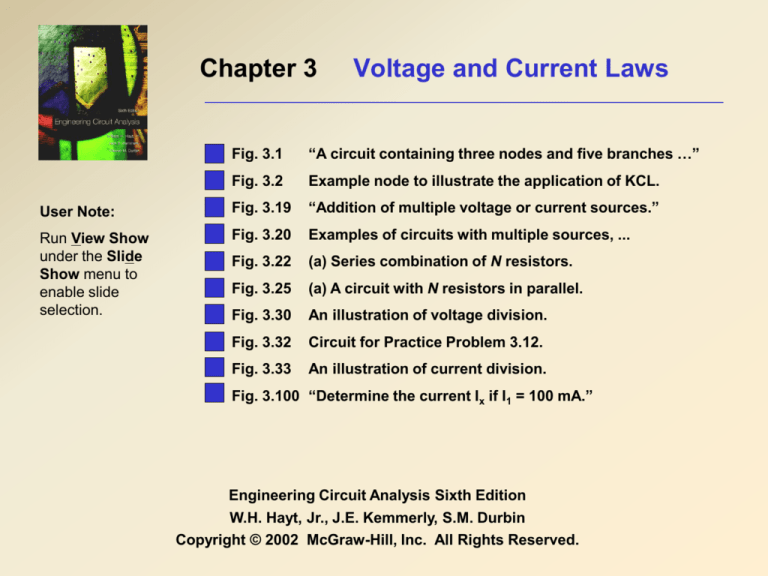
Chapter 3
Voltage and Current Laws
Fig. 3.1
“A circuit containing three nodes and five branches …”
Fig. 3.2
Example node to illustrate the application of KCL.
User Note:
Fig. 3.19
“Addition of multiple voltage or current sources.”
Run View Show
under the Slide
Show menu to
enable slide
selection.
Fig. 3.20
Examples of circuits with multiple sources, ...
Fig. 3.22
(a) Series combination of N resistors.
Fig. 3.25
(a) A circuit with N resistors in parallel.
Fig. 3.30
An illustration of voltage division.
Fig. 3.32
Circuit for Practice Problem 3.12.
Fig. 3.33
An illustration of current division.
Fig. 3.100 “Determine the current Ix if I1 = 100 mA.”
Engineering Circuit Analysis Sixth Edition
W.H. Hayt, Jr., J.E. Kemmerly, S.M. Durbin
Copyright © 2002 McGraw-Hill, Inc. All Rights Reserved.
(a) A circuit containing three
nodes and five branches.
(b) Node 1 is redrawn to look like
two nodes; it is still one node.
W.H. Hayt, Jr., J.E. Kemmerly, S.M. Durbin, Engineering Circuit Analysis, Sixth Edition.
Copyright ©2002 McGraw-Hill. All rights reserved.
Figure 3.2
W.H. Hayt, Jr., J.E. Kemmerly, S.M. Durbin, Engineering Circuit Analysis, Sixth Edition.
Copyright ©2002 McGraw-Hill. All rights reserved.
(a) Series connected voltage sources can be replaced by a
single source. (b) Parallel current sources can be replaced
by a single source.
W.H. Hayt, Jr., J.E. Kemmerly, S.M. Durbin, Engineering Circuit Analysis, Sixth Edition.
Copyright ©2002 McGraw-Hill. All rights reserved.
Examples of circuits with multiple sources,
some of which are “illegal” as they violate
Kirchhoff’s laws.
W.H. Hayt, Jr., J.E. Kemmerly, S.M. Durbin, Engineering Circuit Analysis, Sixth Edition.
Copyright ©2002 McGraw-Hill. All rights reserved.
(a) Series combination of N resistors. (b) Electrically equivalent circuit.
W.H. Hayt, Jr., J.E. Kemmerly, S.M. Durbin, Engineering Circuit Analysis, Sixth Edition.
Copyright ©2002 McGraw-Hill. All rights reserved.
Beginning with a simple KCL equation,
or
Thus,
A special case worth remembering is
(a) A circuit with N resistors in
parallel. (b) Equivalent circuit.
W.H. Hayt, Jr., J.E. Kemmerly, S.M. Durbin, Engineering Circuit Analysis, Sixth Edition.
Copyright ©2002 McGraw-Hill. All rights reserved.
We may find v2 by applying KVL
and Ohm’s law:
so
An illustration of
voltage division.
Thus,
or
For a string of N series resistors, we
may write:
W.H. Hayt, Jr., J.E. Kemmerly, S.M. Durbin, Engineering Circuit Analysis, Sixth Edition.
Copyright ©2002 McGraw-Hill. All rights reserved.
Use voltage division to
determine vx in the adjacent
circuit.
vx
2
2
10V
10V 2V
2 3 10 ||10
2 3 5
W.H. Hayt, Jr., J.E. Kemmerly, S.M. Durbin, Engineering Circuit Analysis, Sixth Edition.
Copyright ©2002 McGraw-Hill. All rights reserved.
The current flowing through R2 is
or
An illustration of
For a parallel combination
of N resistors, the current
through Rk is
current division.
ik
i2
Gk
i
G1 G2 L GN
W.H. Hayt, Jr., J.E. Kemmerly, S.M. Durbin, Engineering Circuit Analysis, Sixth Edition.
Copyright ©2002 McGraw-Hill. All rights reserved.
G2
i
G1 G2
Determine the current Ix if
I1 = 100 mA.
Ix
15
100mA 33.33 mA
15 30
W.H. Hayt, Jr., J.E. Kemmerly, S.M. Durbin, Engineering Circuit Analysis, Sixth Edition.
Copyright ©2002 McGraw-Hill. All rights reserved.
Single-Loop Circuit Analysis
Vs v1 v2 v3 0 KVL
Vs v1 v2 v3 0 KVL
v1 iR1
v
iR
2
2 Ohm's Law
v iR
3
3
v1 iR1
v
iR
2
2 Ohm's Law
v iR
3
3
i R1 R2 R3 Vs
Let Vs 10V , R1 8
i R1 R2 R3 Vs
Let Vs 10V , R1 8
R2 13 and R3 5
R2 13 and R3 5
10V
Then i
0.3846 A
26
and v1 3.0769 V , v2 5 V
10V
0.3846 A
26
and v1 3.0769 V , v2 5 V
v3 1.9231 V.
Then i
v3 1.9231 V.
Single-Node-Pair Circuit Analysis
I s i1 i2 i3
KCL
i1 v / R1 , i2 v / R2 , i3 v / R3 , Ohm's Law
I s v 1 / R1 1 / R2 1 / R3
Let I s 20 mA , R1 1k , R2 3k , R3 7k
0.02A
13.548 V
0.001476 S
i1 13.548 mA , i2 4.516 mA , i3 1.936 mA
Then v
I s i1 i2 i3
KCL
i1 v / R1 , i2 v / R2 , i3 v / R3
Ohm's Law
I s v 1 / R1 1 / R2 1 / R3
Let I s 20 mA , R1 1k , R2 3k , R3 7k
0.02A
13.548 V
0.001476 S
i1 13.548 mA , i2 4.516 mA , i3 1.936 mA
Then v

